
Baroque painting is the painting associated with the Baroque cultural movement. The movement is often identified with Absolutism, the Counter Reformation and Catholic Revival, but the existence of important Baroque art and architecture in non-absolutist and Protestant states throughout Western Europe underscores its widespread popularity.
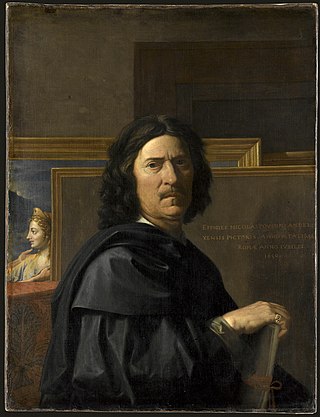
Nicolas Poussin was the leading painter of the classical French Baroque style, although he spent most of his working life in Rome. Most of his works were on religious and mythological subjects painted for a small group of Italian and French collectors. He returned to Paris for a brief period to serve as First Painter to the King under Louis XIII and Cardinal Richelieu, but soon returned to Rome and resumed his more traditional themes. In his later years he gave growing prominence to the landscape in his paintings. His work is characterized by clarity, logic, and order, and favors line over color. Until the 20th century he remained a major inspiration for such classically-oriented artists as Jacques-Louis David, Jean-Auguste-Dominique Ingres and Paul Cézanne.

Et in Arcadia ego is a 1637–38 painting by Nicolas Poussin (1594–1665), the leading painter of the classical French Baroque style. It depicts a pastoral scene with idealized shepherds from classical antiquity, and a woman, possibly a shepherdess, gathered around an austere tomb that includes this inscription. It is held in the Louvre.

Louis Le Vau was a French Baroque architect, who worked for Louis XIV of France. He was an architect that helped develop the French Classical style in the 17th century.
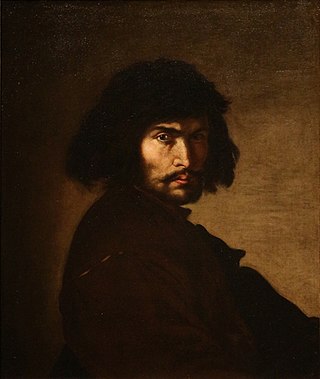
Salvator Rosa is best known today as an Italian Baroque painter, whose romanticized landscapes and history paintings, often set in dark and untamed nature, exerted considerable influence from the 17th century into the early 19th century. In his lifetime he was among the most famous painters, known for his flamboyant personality, and regarded as an accomplished poet, satirist, actor, musician, and printmaker, as well. He was active in Naples, Rome, and Florence, where on occasion he was compelled to move between cities, as his caustic satire earned him enemies in the artistic and intellectual circles of the day.

Simon Vouet was a French painter who studied and rose to prominence in Italy before being summoned by Louis XIII to serve as Premier peintre du Roi in France. He and his studio of artists created religious and mythological paintings, portraits, frescoes, tapestries, and massive decorative schemes for the king and for wealthy patrons, including Richelieu. During this time, "Vouet was indisputably the leading artist in Paris," and was immensely influential in introducing the Italian Baroque style of painting to France. He was also "without doubt one of the outstanding seventeenth-century draughtsmen, equal to Annibale Carracci and Lanfranco."
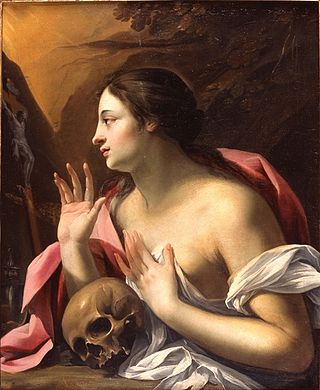
Nicolas Chaperon was a French painter, draughtsman and engraver, a student in Paris of Simon Vouet whose style he adopted before he was further matured by his stay in Rome (1642–51) in the studio of Nicolas Poussin.
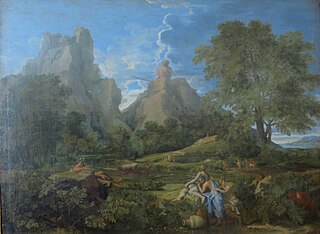
Landscape with Polyphemus is a 1649 oil painting by French artist Nicolas Poussin.
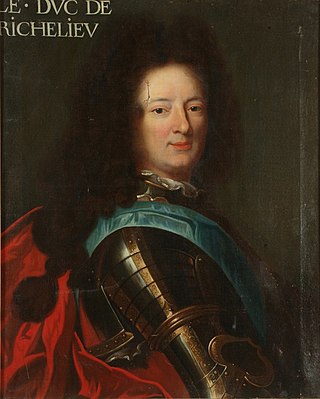
Armand-Jean de Vignerot Du Plessis, duc de Richelieu, was a French naval officer and nobleman. His surname has also been spelled Vignerod Duplessis.

The Four Seasons was the last set of four oil paintings completed by the French painter Nicolas Poussin (1594–1665). The set was painted in Rome between 1660 and 1664 for the Duc de Richelieu, the grand-nephew of Cardinal Richelieu. Each painting is an elegiac landscape with Old Testament figures conveying the different seasons and times of the day. Executed when the artist was in failing health suffering from a tremor in his hands, the Seasons are a philosophical reflection on the order in the natural world. The iconography evokes not only the Christian themes of death and resurrection but also the pagan imagery of classical antiquity: the poetic worlds of Milton's Paradise Lost and Virgil's Georgics. The paintings currently hang in a room on their own in the Louvre in Paris.
By his absolute humility, by his effacement of himself, by his refusal to use any tricks or overstate himself, Poussin has succeeded in identifying himself with nature, conceived as a manifestation of the divine reason. The Seasons are among the supreme examples of pantheistic landscape painting.
Jamais peut-être, dans toute la peinture occidentale, des choses aussi nombreuses et parfois si difficiles n'avaient été dites avec une telle simplicité. Jamais un peintre ne s'était aussi pleinement identifié à l'ordre du monde. Mais cette identification n'est ni « une projection » ni une confidence : là est le sens de cette impersonalité que l'on a pu reprocher à Poussin, et qui fait sa grandeur.

The Mystic Marriage of Saint Catherine is a painting by Correggio dating about the mid-1520s currently held and exhibited at the Louvre in Paris, France.

Fishing is a painting by Italian artist Annibale Carracci, painted before 1595 and given to Louis XIV by Prince Camillo Pamphili in 1665. It is currently held and exhibited at the Louvre in Paris.

Landscape with Orpheus and Eurydice is a 124 × 200 cm oil-on-canvas painting by the French artist Nicolas Poussin, painted between 1650 and 1653. It depicts a mythological subject in the classical style and is in the collection of the Louvre in Paris.
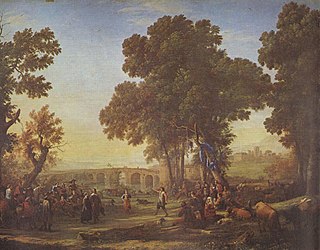
Village Fête is an oil-on-canvas by French artist of the Baroque Claude Lorrain, painted in 1639 and given to Louis XIV in 1693 together with its companion Seaport at Sunset, by landscape architect and gardener André Le Nôtre. It is currently held and exhibited at the Louvre in Paris.

The Adoration of the Shepherds is a painting of 1633–34 by the French painter Nicolas Poussin (1594–1665), now in the National Gallery, London. It is in oils on canvas, and measures 97.2 by 74 centimetres. Unusually for Poussin, it is signed "N. Pusin.fe" ["fecit"] on the stone at lower right. By 1637, soon after it was painted, it was owned by Cardinal Gian Carlo de' Medici (1611–1663), the second son of Grand Duke Cosimo II of Tuscany and was placed in his villa outside Florence.

Everhard or Eberhard Jabach was a French businessman, art collector and director of the French East India Company. He was born in Cologne in the Holy Roman Empire but later naturalised as a French subject.

The Pastoral Concert or Le Concert Champêtre is an oil painting of c. 1509 attributed to the Italian Renaissance master Titian. It was previously attributed to his fellow Venetian and contemporary Giorgione. It is now in the Musée du Louvre in Paris.

Saint James the Great's Vision of the Virgin Mary is a c.1629-1630 oil on canvas painting by Nicolas Poussin, now in the Louvre Museum. It shows a vision in Zaragoza whilst James the Great was evangelising Spain.

Apollo and Daphne or Apollo in Love with Daphne is a 1661-1664 oil on canvas painting by Nicolas Poussin, produced just before the painter's death and now in the Louvre Museum.



















